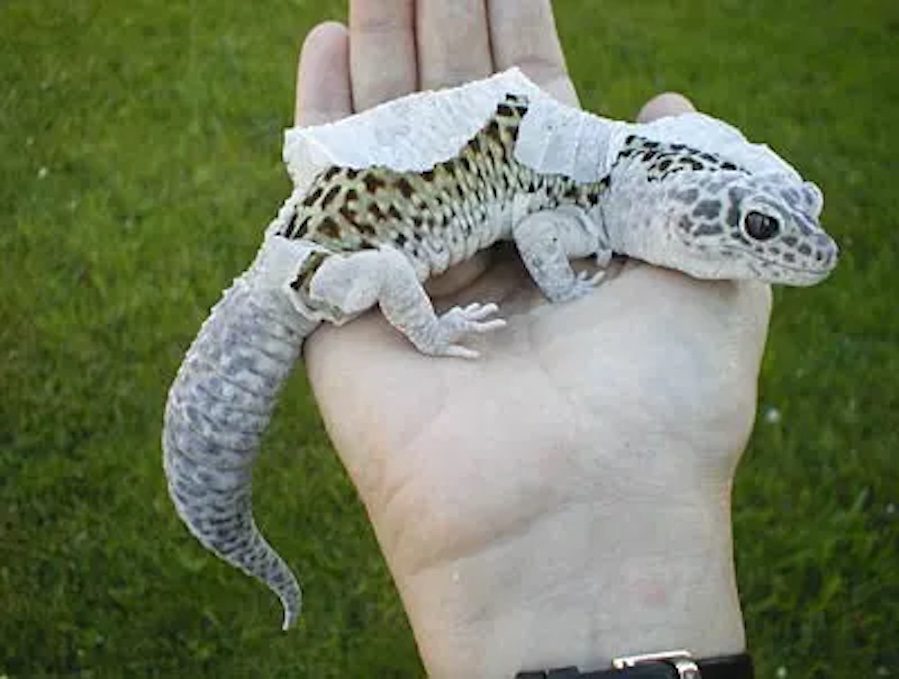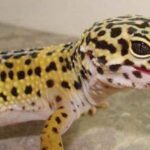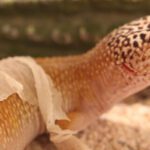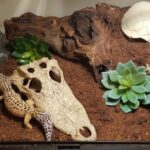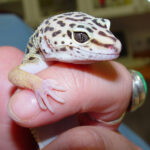Leopard geckos, like many reptiles, periodically shed their skin as part of their natural growth cycle. This process, called ecdysis, occurs more frequently in younger geckos as they grow rapidly, with adults shedding less often. Typically, baby and juvenile leopard geckos shed every 10 to 14 days, while adult geckos shed every 4 to 8 weeks.
During shedding, their skin color turns dull, changing from white to grey before pieces begin to peel off. Many leopard geckos will eat their shed skin, a natural behavior that helps them retain nutrients.
In ideal conditions, the shedding process is smooth, often taking only an hour or two. However, abnormal shedding, or dysecdysis, can occur, especially in low-humidity environments. Recognizing the signs of healthy versus problematic shedding helps owners manage and prevent potential issues.
Table of Contents
Causes of Abnormal Shedding in Leopard Geckos
Abnormal shedding in leopard geckos can stem from various factors, with environmental issues such as low humidity and incorrect temperature being among the most common. Other causes include skin infections, vitamin deficiencies (notably vitamin A), stress, and handling during shedding periods. Health problems like skin parasites or injuries can also interfere with proper shedding.
Identifying the root cause is essential, as dysecdysis often signals underlying husbandry issues. Maintaining accurate humidity and temperature in their enclosure is crucial, as both can directly influence the gecko’s shedding frequency and ease. Monitoring their habitat and nutritional intake can prevent most cases of abnormal shedding.
Recognizing Signs of Abnormal Shedding
Signs of abnormal shedding in leopard geckos include prolonged shedding (taking longer than a few hours), incomplete shedding where small skin pieces remain stuck, or unusually long intervals between sheds. When humidity levels are too low, geckos may struggle with dry, retained skin on various body parts, leading to discomfort and possible health complications.
This retained skin, especially on toes and tail tips, can cause restricted blood flow, ultimately leading to necrosis or even limb loss if not addressed promptly.
Leopard geckos with abnormal shedding may exhibit behavioral cues, such as spending more time soaking in their water dish. This soaking behavior is often a self-initiated attempt to loosen the retained skin, indicating that their habitat’s humidity may be insufficient.
Environmental Factors Affecting Skin Shedding
Humidity
Maintaining appropriate humidity levels is vital for a smooth shedding process. Low humidity is a common culprit for shedding issues, as a dry environment makes it difficult for old skin to loosen and peel off naturally.
Geckos in low-humidity settings may develop shedding problems, especially if they lack a moist shelter or humidity-controlled area. A humid hide box, filled with damp substrates like sphagnum moss, can provide an ideal microenvironment to support the shedding process.
Commercially available products like Zoo Med’s all-natural, sustainably sourced sphagnum moss can be used as a substrate in humid hides, ensuring a safe, dye-free environment for geckos.
Temperature
Leopard geckos thrive in warm temperatures, ideally ranging from 25–30°C (77–86°F) with a slight drop to room temperature at night. If temperatures are too low, geckos may experience stress, slowed growth, and even shedding difficulties. Conversely, overly high temperatures can dry out their environment, reducing humidity and forcing geckos to spend more time soaking. Maintaining a consistent, suitable temperature is essential for both their overall health and ease of shedding.
Temperature management can be monitored using reliable thermometers within the enclosure to ensure the gecko’s habitat meets their specific needs.
Nutritional and Health-Related Factors in Shedding
Malnourishment
Malnourished leopard geckos are more susceptible to shedding difficulties. A diet lacking in essential nutrients can extend shedding cycles and lead to irregular, problematic sheds. In extreme cases, geckos with protein deficiencies may lack the necessary enzymes to separate old and new skin layers effectively, making shedding more challenging.
Feeding a balanced diet and ensuring proper supplementation are crucial for maintaining healthy shedding cycles.
Vitamin A Deficiency (Hypovitaminosis A)
Vitamin A deficiency, or hypovitaminosis A, is a notable contributor to shedding issues. This deficiency not only complicates shedding but can also lead to various eye problems, such as conjunctivitis and periocular abscesses. Leopard geckos relying solely on non-gut-loaded crickets may lack adequate vitamin A, as crickets do not store this nutrient.
Supplementing their diet with gut-loaded insects or vitamin supplements is important, but care should be taken to avoid overdosing, which can lead to skin-related complications.
Complications of Dysecdysis in Leopard Geckos
When leopard geckos experience repeated abnormal shedding, it can lead to severe complications. Retained skin, particularly on toes, tails, or other extremities, can constrict blood flow, acting like a tourniquet. This constriction can cause tissue death, known as avascular necrosis, potentially leading to toe or limb loss if untreated.
In addition, retained skin can harbor bacteria and fungi, creating an environment ripe for secondary infections, especially around the eyes, mouth, and other sensitive areas.
Eye infections like keratitis and conjunctivitis are common complications when skin is retained near the eyes. Addressing these issues promptly can help prevent further health deterioration.
Treatment Options for Shedding Problems in Leopard Geckos
Treating shedding issues in leopard geckos involves three primary steps: removing retained skin, addressing the underlying cause, and managing any complications. Increasing the enclosure’s humidity or providing a moist hide can help prevent future problems. During the shedding process, daily misting and lukewarm baths may assist in loosening the skin.
If skin remains stuck around sensitive areas like toes or the tail, soaking the area in lukewarm water and gently removing it with damp cotton swabs can help.
For stuck skin around the eyes, additional treatments or medications might be necessary to prevent infections. In cases where shedding issues persist despite corrective measures, consulting a reptile veterinarian is advisable for further assessment and treatment.
Long-Term Management and Prevention of Shedding Issues
To prevent future shedding problems, maintaining an optimal habitat is essential. Monitoring temperature and humidity consistently, ensuring a balanced diet, and providing periodic nutritional supplements are all proactive steps.
Keeping records of shedding patterns and adjusting care as needed can help identify early signs of potential issues.
When dealing with potential vitamin deficiencies, gradual dietary changes and supplements should be administered to avoid overdosing. Regular health checkups with a reptile veterinarian can also help identify and address underlying issues before they escalate, ensuring your leopard gecko remains healthy and comfortable.
Conclusion
Abnormal shedding, or dysecdysis, in leopard geckos is commonly a result of environmental or dietary imbalances. By maintaining correct humidity levels, ensuring a balanced diet with appropriate supplements, and providing a stress-free environment, many shedding issues can be avoided. In persistent or severe cases, professional veterinary help is crucial to address any underlying health concerns.
With the right care and attention, leopard geckos can enjoy a smooth, regular shedding process, contributing to their overall well-being and longevity.

